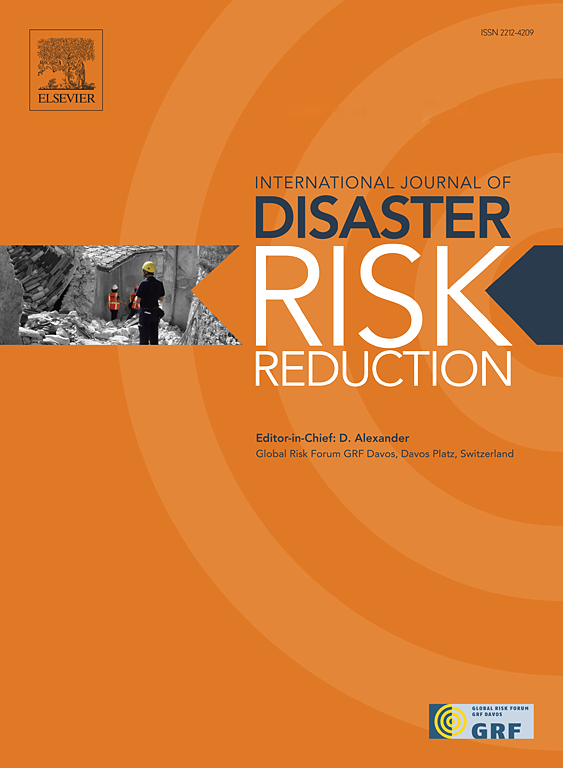Supply chain resilience capabilities: an outlook of the Brazilian agri-food sector post COVID-19 pandemic
IF 4.5
1区 地球科学
Q1 GEOSCIENCES, MULTIDISCIPLINARY
International journal of disaster risk reduction
Pub Date : 2025-04-15
DOI:10.1016/j.ijdrr.2025.105486
引用次数: 0
Abstract
This study proposed a research model to assess and characterize the level of development of resilience capabilities in agri-food companies. This study surveyed 208 professionals from Brazilian agri-food companies. Data were analyzed using different quantitative techniques (t-tests, ANOVA, and cluster analysis). This study proposed and validated a multidimensional construct for resilience capabilities formed by the macro-dimensions of Readiness, Response, and Recovery. This study found that Brazilian agri-food companies present a moderately high level of resilience capabilities. Cluster analysis identified three clusters (low, moderate, and high levels of resilience), with fewer firms included in the low-performance cluster. A lower development level was observed for the Flexibility, Collaboration, and Consciousness Awareness capabilities, while a higher level was identified for the Knowledge Management and Agility capabilities. Significant statistical differences regarding firm sizes for the dimensions of readiness and recovery were observed. Most micro companies are at a moderate resilience level. Among the firms with low resilience levels are the ones from the Agroindustry segment and some medium and large companies. On the other hand, the Agricultural and Livestock Production sectors present high levels of resilience. The Dynamic Capabilities View theory is extended by showing that specific capabilities are needed to increase firms’ resilience levels in turbulent environments and achieve higher resilience levels. Our study presents contributions to policymakers and agri-food companies. We argue that public policies should focus on promoting collaboration among companies and firms should invest in strategic partnerships and supply chain monitoring systems to improve their resilience level.
供应链抵御能力:2019冠状病毒病大流行后巴西农业食品行业展望
本研究提出了一个评估农业食品企业弹性能力发展水平的研究模型。这项研究调查了来自巴西农业食品公司的208名专业人士。数据分析采用不同的定量技术(t检验、方差分析和聚类分析)。本研究提出并验证了由准备、反应和恢复三个宏观维度构成的弹性能力的多维结构。本研究发现,巴西农业食品公司表现出中等水平的弹性能力。聚类分析确定了三个集群(低、中等和高水平的弹性),低绩效集群中包含的公司较少。较低的开发层次是针对灵活性、协作和意识意识能力,而较高的开发层次是针对知识管理和敏捷性能力。关于企业规模的准备和恢复的维度显著的统计差异被观察到。大多数微型公司处于中等弹性水平。在弹性水平较低的企业中,有农业工业部门的企业和一些大中型企业。另一方面,农业和畜牧业生产部门表现出较高的抵御能力。动态能力观理论得到扩展,表明需要特定的能力来提高企业在动荡环境中的弹性水平,并达到更高的弹性水平。我们的研究为政策制定者和农业食品公司做出了贡献。我们认为,公共政策应侧重于促进企业之间的合作,企业应投资于战略伙伴关系和供应链监控系统,以提高其弹性水平。
本文章由计算机程序翻译,如有差异,请以英文原文为准。
求助全文
约1分钟内获得全文
求助全文
来源期刊

International journal of disaster risk reduction
GEOSCIENCES, MULTIDISCIPLINARYMETEOROLOGY-METEOROLOGY & ATMOSPHERIC SCIENCES
CiteScore
8.70
自引率
18.00%
发文量
688
审稿时长
79 days
期刊介绍:
The International Journal of Disaster Risk Reduction (IJDRR) is the journal for researchers, policymakers and practitioners across diverse disciplines: earth sciences and their implications; environmental sciences; engineering; urban studies; geography; and the social sciences. IJDRR publishes fundamental and applied research, critical reviews, policy papers and case studies with a particular focus on multi-disciplinary research that aims to reduce the impact of natural, technological, social and intentional disasters. IJDRR stimulates exchange of ideas and knowledge transfer on disaster research, mitigation, adaptation, prevention and risk reduction at all geographical scales: local, national and international.
Key topics:-
-multifaceted disaster and cascading disasters
-the development of disaster risk reduction strategies and techniques
-discussion and development of effective warning and educational systems for risk management at all levels
-disasters associated with climate change
-vulnerability analysis and vulnerability trends
-emerging risks
-resilience against disasters.
The journal particularly encourages papers that approach risk from a multi-disciplinary perspective.
 求助内容:
求助内容: 应助结果提醒方式:
应助结果提醒方式:


